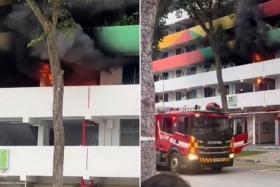Why does HDB incur a deficit every year? How are new flats priced?
The Housing Board’s deficit nearly doubled to a record $4.367 billion in the financial year ended March 31, from $2.346 billion the year before.
The higher deficit is largely due to more Build-To-Order (BTO) projects starting construction as well as more subsidies and grants disbursed to buyers, said HDB, which released its annual report on Monday.
Here is what you need to know about HDB’s deficit.
Q. How and why does HDB incur a deficit every year?
A: HDB makes a loss on each flat it develops, as it builds and sells new flats at subsidised prices below market rates.
This means the more flats HDB sells in a year, the higher the deficit it incurs.
In the 2021/2022 financial year, HDB launched 17,322 new flats across four sales exercises. A total of 13,506 units were completed and handed to buyers, up from the 8,124 units the year before.
HDB incurs land and construction costs when it develops flats. Land is purchased from the state at fair market value, based on the chief valuer’s independent assessment.
However, the amount collected from buyers from the sale of flats is less than the total development costs incurred by the HDB, said HDB chief executive Tan Meng Dui.
As a result, HDB incurs deficits from the sale of flats yearly. The deficit has grown every year, except in the 2020/2021 financial year when it dropped to $2.34 billion from $2.66 billion the previous year, as the Covid-19 pandemic hampered construction.
Q: Why has the deficit almost doubled?
A: The bulk of the record deficit – $3.85 billion – was due to the expected loss for flats being built, disbursement of Central Provident Fund housing grants and a gross loss on the sale of subsidised flats.
In the 2021/2022 financial year, HDB launched and delivered more new flats to buyers compared with the previous years. This translates to more subsidies and housing grants provided to buyers, which pushes up the amount of deficit incurred.
Construction costs have also increased by about 30 per cent since the 2019/2020 financial year, due to pandemic-related disruptions. HDB said it has largely absorbed these costs.
HDB’s annual deficit is fully covered by a grant from the Finance Ministry.
In the 2021/2022 financial year, HDB received a grant of $4.4 billion, up from $2.346 billion the year before. The cumulative government grants provided to the HDB since its establishment in 1960 stand at $42.97 billion.
Q: How are new HDB flats priced?
A: New flats are priced based on a number of affordability benchmarks, and not on the total development costs incurred by HDB, which comprise construction and land cost.
HDB determines the market value of new flats from comparable resale flats nearby, and applies a significant subsidy to keep them affordable based on household incomes and the pricing of various flat types on offer.
The current house price to income ratio for BTO flats offered in non-mature estates is around five or less, said HDB, which means the purchase price is five times the annual household income or less.
The mortgage servicing ratio (MSR) for most new flat buyers taking HDB loans is around 25 per cent or less, meaning they spend a quarter or less of their monthly income on their mortgage.
In the first nine months of 2022, HDB said the median prices of BTO flats in non-mature estates are $228,000 for three-room flats, $347,000 for four-room flats and $473,000 for five-room flats.

Q: Will the deficit increase next year?
A: HDB said the number of flats supplied and prevailing market conditions affecting development costs would have an impact on its deficit.
The Board’s overall deficit is set to increase, as it has announced plans to ramp up the supply of BTO flats to meet strong housing demand.
HDB is on track to launch up to 23,000 new flats in 2022 and 2023.
It is also prepared to launch up to 100,000 flats from 2021 to 2025 if needed, subject to prevailing demand
Get The New Paper on your phone with the free TNP app. Download from the Apple App Store or Google Play Store now


